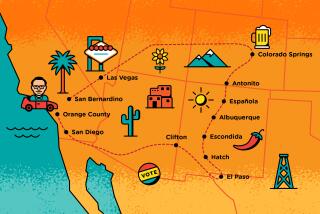The Cambridge History of Latin America, Vols. IV and V, 1870-1930 edited by Leslie Bethell (Cambridge University: $69.50 and $79.50; 676 and 951 pp.)
- Share via
Several years ago, President Reagan returned from a short trip to Latin America to express surprise that the countries there were all different. Rather than merely reflecting the President’s own idiosyncratic expectations, his surprise was typical of the perceptions of our policy-makers and indeed of the U.S. public in general.
All of the countries of Latin America are thought to be the same, with similar presents and similar pasts. But, in fact, they are quite diverse. This is pointed out in the latest two volumes of “The Cambridge History of Latin America,” which focuses on the 1870-to-1930 period when their differences greatly accelerated as Latin America witnessed enormous economic and social change. Tropical raw materials shipped to Europe and North America stimulated unprecedented economic growth. Foreign capital, markets and immigrants swelled Buenos Aires, Mexico City and Sao Paulo and filled the coffers of federal treasuries. The countryside also felt the effects of “the inexorable growth of the market and population.” Indeed, “During the 60 years following 1870, the rural people of Spanish America probably underwent a greater change than at any previous time in their history except for the Conquest itself.”
Twenty years ago, this period would have been seen sanguinely as the onset of modernization, the “Golden Age of predominantly export-led growth.” Ten years ago, these decades would more likely have been condemned as the era of the intensification of neo-colonial, dependent relations with Europe and America. Both perceptions tended to paint the history of Latin America with a single brush and a limited palette.
Volumes IV and V of “The Cambridge History of Latin America,” a projected eight-volume series, suggest that today’s historians pose more complex questions and are wary of simplistic answers. The editor, British historian Leslie Bethell, has brought together a collection of 33 of the finest historians of Latin America. Ten are from Latin America, demonstrating the growth of the historical profession there. The rest are evenly divided between Europeans and North Americans. The essays reflect the field’s variety of approaches and concerns as well as its maturity and sophistication.
The two volumes are complementary. Volume IV treats pan-Latin American topics such as economic growth and its social and spatial impact, the role of the United States, the Catholic Church and intellectual and artistic trends. Its choice of subjects points up the ascendancy of social and economic history. Volume V examines national histories, emphasizing political and to a lesser degree economic affairs. The articles here tend to stress conjunctural events rather than the long-term structures that are highlighted in Volume IV. They also demonstrate the relative importance accorded to the various national histories: Mexico, Brazil and Argentina occupy more than half of the volume; the rest is divided up among 15 countries. This imbalance is particularly noticeable in respect to Central America and Colombia, Ecuador and Venezuela, which combined, are discussed in two short chapters.
Perhaps the most striking thing about this collection is the different historical experiences of the countries of Latin America. Yes, almost all underwent export-led growth; foreign investment was important in all of them; they all labored under some form of oligarchic government, and they all undertook liberal reforms and began the transition toward capitalism. But the nature and extent of these phenomena varied greatly.
Argentina, according to R. Cortes Conde, was the most successful at developing. It most closely fit the modernization model. Booming international markets for beef, wool and wheat, a flood of foreign capital and 6 million immigrants helped the population quadruple and the economy spurt ahead. A nationally integrated economy developed as cities expanded, the middle class ballooned, workers’ real wages rose by a third and a large yeoman farmer class arose. Literacy and health care improved markedly as well. Indeed, because of these strides, some observers regarded Argentina as a developed country by the 1920s. Uruguay and Chile also enjoyed substantial development and improved general welfare.
In countries such as Mexico and the Dominican Republic, on the other hand, greater integration into the world economy whetted the appetite of large-scale landowners for land, forcing the vast majority of the peasantry off of their small farms. In these countries, as A. Bauer, C. Cardoso, F. Katz and H. Hoetink point out, the rich got richer and the poor had poor babies. Domestic markets were slow to develop; most cities grew slightly, and the standard of living for most people improved little, if at all.
Brazil, with its archipelago pattern of settlement, was a third variant. European and North American thirst for coffee generated widespread growth that inspired some true economic development in the Minas-Rio de Janeiro-Sao Paulo heartland of Brazil; however, most of the rest of the country, particularly the Northeast, stagnated.
The great variation in local responses to the incursion of the forces of the world economy betrays the overly simplistic forms of analysis that have been often applied to Latin America. Even in such apparently similar countries as Guatemala, El Salvador and Costa Rica, all small, dependent coffee-exporters, the impact on peasants differed greatly. C. Cardoso points out in a stimulating essay on Central America that because coffee in Guatemala was grown on the Pacific Coast, away from the concentration of indigenous population in the highlands, the native populations were largely left unmolested in the first decades of the coffee boom. In Costa Rica, with its absence of indigenous peoples and a colonial heritage of small holders, coffee created a rural middle class. In El Salvador, on the other hand, coffee was best grown in the areas most densely populated by Indians and mestizos. The pre-existing hacendado class was inspired by growing world demand for coffee to enlarge its estates and expropriate the lands of peasants, creating a large rural proletariat.
The political systems that directed the export economies were almost as varied as the social formations they reflected. Argentina and Uruguay and, to a lesser extent, Chile replaced oligarchic governments with more popular urban-based ones. Brazil established an oligarchic representative republic; many of the other countries suffered caudillo dictatorships. And Mexico experienced what has been called the first social revolution of the 20th Century.
These two long and unfortunately expensive volumes assume a fair amount of prior knowledge. Moreover, they are not unified by any overt common theme, since the editor’s introduction is quite brief in each volume, and the essays do not refer to each other nor to a common concern. Nonetheless, the interested reader will find many of the essays stimulating, though not always entertaining. They represent the state of the art of Latin American history today and reveal the complex mosaic of Latin America’s past. They also yield an important lesson about our neighbors to the south, one that would greatly benefit our current policy-makers: The countries of Latin America are all different with unique problems and possibilities. It would behoove the United States to act upon this insight.
More to Read
Sign up for Essential California
The most important California stories and recommendations in your inbox every morning.
You may occasionally receive promotional content from the Los Angeles Times.










